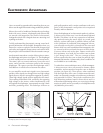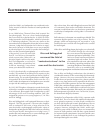
Home Theater 13
It had long been the practice of stereo buffs to connect their
television to a stereo system. The advantage was the use of
the larger speakers and more powerful amplifier of the
stereo system. Even though the sound was greatly improved,
it was still mono and limited by the broadcast signal.
In the late 1970’s and early 1980’s two new home movie
formats became widely available to the public: VCR and
laser disc.
By 1985, both formats had developed into very high quality
audio/video sources. In fact, the sonic performance of some
video formats exceeded audio-only formats. Now, with
theater-quality sound available at home, the only element
missing was the "surround sound" presentation found in
movie houses.
Fortunately, Dolby and DTS encoded movies (including
almost all films) have the same surround sound informa-
tion encoded on home releases as the theatrical release.
All that is required to retrieve this information is a decoder
and additional speakers and amps to reproduce it.
Home theater is a complex purchase and we recommend
that you consult your local MartinLogan dealer, as they
are well versed in this subject.
Each piece of a surround system can be purchased sepa-
rately. Take your time and buy quality. No one has ever
complained that the movie was too real. The following list
and descriptions will give you only a brief outline of the
responsibilities and demands placed on each speaker.
Front Left and Front Right
If these speakers will be the same two used for your stereo
playback, they should be of very high quality and able to
play loudly (over 102 dB) and reproduce bass below 80 Hz.
Center Channel
This is the most important speaker in a home theater
system, as almost all of the dialogue and a large portion
of the front speaker information is reproduced by the
center channel. It is important that the center speaker
be extremely accurate and mate well with the front
speaker, and that it is recommended for use as a center
speaker. This is not the place to cut corners.
Surround Speakers
We recommend (along with the film industry) that the sur-
round speakers play down to at least 80 Hz. Surround
speakers contain the information that makes it appear that
planes are flying over your head. Some may suggest that this
is the place to save money and purchase small, inexpensive
speakers. If you choose to do so, be prepared to upgrade
in the future as discrete multi-channel digital encoding is
proliferating rapidly and the demands on surround speak-
ers have increased.
Subwoofer
With any good surround system you will need one or
more high-quality subwoofers (the .1 in a 5.1, 6.1, or
7.1 channel surround system). Most movie soundtracks
contain large amounts of bass information as part of the
special effects. Good subwoofers will provide a founda-
tion for the rest of the system.
HOME THEATER
Figure 18. Summit speakers as front channels, the Stage as the center
channel, Script i speakers as side surround (effects) channels, and Descent
subwoofers as 0.1 (effects) channel.


















